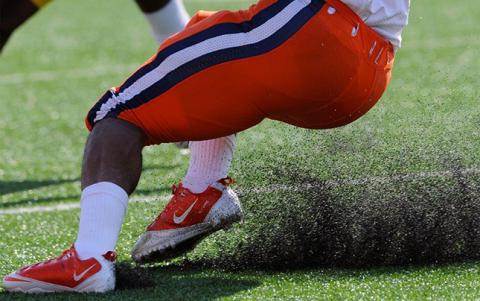Public health concern for playing on synthetic turf fields with crumb rubber infill has increased in recent years. Crumb rubber manufactured from recycled automobile tires contains potential carcinogenic and toxic substances, and, with over 12,000 synthetic turf fields in the United States, the potential for exposure is widespread. The National Toxicology Program (NTP) conducted research to improve the understanding of potential human exposure to crumb rubber and its biological activity. As a part of the NTP research program, a crumb rubber lot, prepared by combining material from multiple commercial sources, was analyzed using a variety of techniques to generate information on chemical and physical characteristics.
Optical and scanning electron microscopy demonstrated that the lot consisted of a range of particle sizes (0.1–4 mm) and types (dark and light rubber, visible inclusions, fibers). Thermogravimetric analysis revealed that the lot contains a minute fraction of volatile organic compounds (VOCs) and ~8% inorganics by weight. Elemental analysis by inductively coupled plasma with atomic emission spectrometry or mass spectrometry (MS) identified zinc, aluminum, cobalt, and other metals and metalloids totaling ~2.9% by weight. Analysis for VOCs by gas chromatography (GC) and MS with headspace sampling detected a large number of constituents; 33 compounds were identified totaling ~0.0007% by weight in crumb rubber.
Extraction of crumb rubber with multiple solvents covering different polarities showed that 0.6% and ~8% by weight, respectively, were extracted with water and methylene chloride, demonstrating that most of the extractable material consists of relatively non-polar organics. Analysis of methylene chloride extract by GC–MS identified 42 compounds with high confidence using authentic standards or reference library spectra, 7 of which were also identified in the VOC analysis, and 62 compounds with lower confidence using reference library spectra, 9 of which were also identified in the VOC analysis. An additional ~200 compounds previously reported to be in crumb rubber were investigated but were not detected in the extracts of the current lot under the conditions used. Analysis of ethanol extracts of crumb rubber by liquid chromatography coupled with MS did not reveal any new analytes not previously detected by GC–MS.
These data demonstrate that VOCs and metals constitute a very small fraction of the crumb rubber lot. In vitro bioaccessibility studies to mimic various routes of exposure showed that only a limited number of constituents are present in these fluids, regardless of the biofluid or the analytical method used.
National Toxicology Program (NTP). 2019. NTP research report on the chemical and physical characterization of recycled tire crumb rubber. Research Triangle Park, NC: National Toxicology Program. Research Report 11. https://doi.org/10.22427/NTP-RR-11


